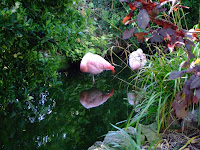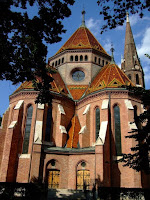
The 'official' Danube tourist boat trips have optional excursions to look at the sights on the Danube Bend; our cheapie homespun Danube trip had us whistle straight past these spots at 65 kph so we had to make our own arrangements to get back to these towns.
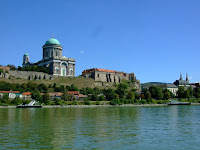
We began the day with a trip in a modern spacious comfortable air-conditioned train from Budapest to Esztergom where there is a Basilica that is far too big and grand for the smallish town where it sits on the hilltop overlooking an S-bend in the Danube. The painting over the altar is supposedly the largest painting on a single canvas and is a copy of Titian's Assumption.

For a small fee, one can climb the 413 steps to the walkway around the cupola for an absolutely stunning view of the Danube and the surrounding area. Having walked around the outside of the cupola, we were about to descend when the attendant at the top beckoned us to follow through a fenced-off area. He took us halfway round the cupola, demonstrating the amazing echoes on the way. At the halfway point, he indicated that we should stay while he returned to the other side.
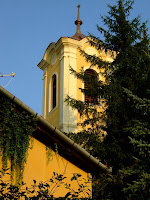
He then treated us to our own private demonstration of the amazing acoustics in the space between the internal dome of the Basilica and the external roof of the cupola. Apart from worrying that this delay might mean that we would miss the hourly bus to our next stop, it was rather a special treat.
We raced back down the hill and realised that we did not have time to make it back to the bus station. We saw a bus with the correct name on its destination board and asked the driver.
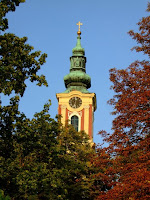
He indicated that we were to wait on the other side of the street for the bus that would take us to Visegrad, so we duly did.
The bus came and drove straight past the bus stop. Seeing our consternation, a friendly local indicated that the correct bus stop was a further 100m up the road so we raced after the bus. Fortunately the traffic lights were against the bus and in our favour and there was a horde of people waiting so we had no bother catching the old rickety totally overcrowded hot and steamy bus.

Eventually the crowd on the bus thinned and we could get a seat as we followed the Danube round to Visegrad. We left the bus there and slogged up the 350m climb to the fortress on the hill overlooking another S-bend. The views from the top did compensate, although the payment to visit the castle is not really worth it. However, no payment, no view.

After slithering down the more direct path to the road via St Stephen's Tower we waited for the next bus to arrive. Neither the path from the town or the path from St Stephen's Tower qualify for any better status than 'rough tramping tracks requiring sturdy boots';

we had our sandals and although both paths had been streams very recently following overnight rain, we made the round trip without incident.
Our last stop was the totally delightful town of Szentendre. Its pedestrianised centre is very twee and after exploring thoroughly we enjoyed a truly memorable

meal at the Elisabeth restaurant in the square. Night had fallen as we made our way to the station at the end of the suburban HEV train line for our ride back to Budapest, leaving us a short stroll along the Danube to enjoy the city by night.
 We have visited Chiddingstone a number of times as it is a very pretty little village in Kent and on each occasion we have wondered what was behind the gate at the end of the street. The gate allows access to Chiddingstone Castle so today we decided to fill that gap in our knowledge.
We have visited Chiddingstone a number of times as it is a very pretty little village in Kent and on each occasion we have wondered what was behind the gate at the end of the street. The gate allows access to Chiddingstone Castle so today we decided to fill that gap in our knowledge. It is not a real castle, just a castlefied country house and it holds the collection of Denys Bower which includes an amazing array of Japanese art treasures and military pieces including a number of suits of armour.
It is not a real castle, just a castlefied country house and it holds the collection of Denys Bower which includes an amazing array of Japanese art treasures and military pieces including a number of suits of armour.
 From there we went to Titsey House, once the family home of the Greshams. They came to London and made their fortunes in the Tudor period as mercers and two of the brothers became Lord Mayor.
From there we went to Titsey House, once the family home of the Greshams. They came to London and made their fortunes in the Tudor period as mercers and two of the brothers became Lord Mayor. However, the most famous Gresham was their cousin who founded the London Stock Exchange and adorned it with the golden grasshopper from his family crest and a golden grasshopper adorns the LSE to this day.
However, the most famous Gresham was their cousin who founded the London Stock Exchange and adorned it with the golden grasshopper from his family crest and a golden grasshopper adorns the LSE to this day.



